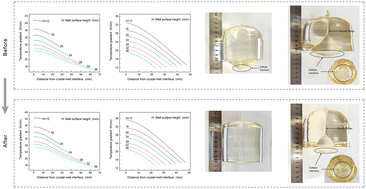Effect of exposed crucible wall on the Czochralski growth of an LN crystal
Abstract
The thermal field systems of 7.6 cm and 10.2 cm lithium niobate (LN) crystals grown by an induction heating Czochralski method were designed, and both of the thermal fields were simulated. The effect of an exposed crucible wall and the influence of the crucible position on the growth of the LN crystals were investigated using simulations and experiments. Our results show that the axial temperature gradient in the crystal and the melt decreased gradually with the increased height of the exposed crucible wall during the crystal growth. From the early to the late stage of cylindrical growth, the axial temperature gradient near the crystal–melt interface in the 7.6 cm and 10.2 cm thermal fields decreased by about 45% and 50%, respectively. Meanwhile, the shape of the crystal–melt interface gradually became convex towards the melt. At the late stage of the crystal growth, the cellular interface and growth ridge spread, resulted in the deterioration of crystal quality, and the over-convex crystal–melt interface lead to the growth can not continue. Lifting the crucible position appropriately could increase the temperature gradient in the crystal and the melt, inhibit the spread of the growth ridges and the cellular interface growth, and reduced the convexity of the crystal–melt interface, which were verified by the results of the crystal growth experiments.



 Please wait while we load your content...
Please wait while we load your content...